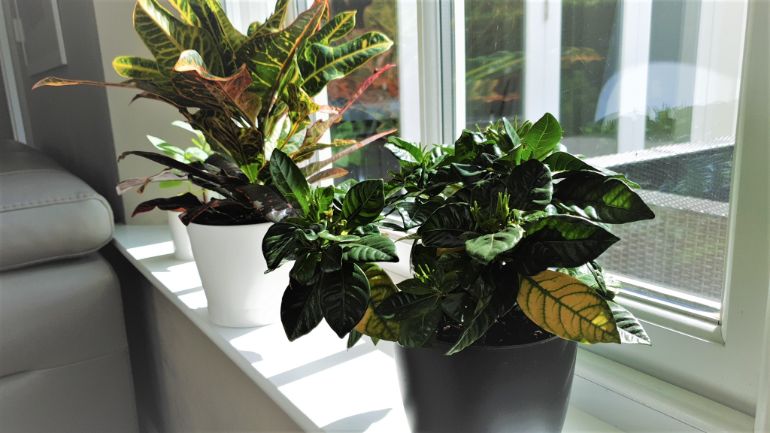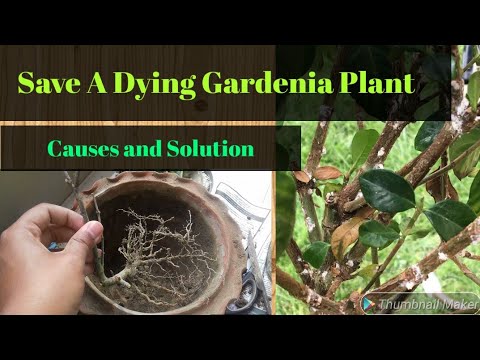To treat a dying gardenia plant, provide adequate sunlight, water, and proper drainage, and address any pest or disease issues promptly. Gardenias are beautiful and fragrant flowering plants that require special care to thrive.
However, even with the best intentions, gardenias can sometimes deteriorate and appear to be dying. If you find yourself in this situation, you can take several steps to revive your beloved plant. By understanding the specific needs of gardenias and providing the correct environmental conditions, you can help bring your dying gardenia back to life.
We will discuss how to treat a dying gardenia plant, including steps such as providing adequate sunlight, water, and proper drainage, as well as addressing any pest or disease issues promptly. So, let’s get started and learn how to bring your gardenia back to its vibrant and healthy state!

Credit: smartgardenguide.com
How to Treat a Dying Gardenia Plant: Step by Step Guide
Identifying Symptoms Of A Dying Gardenia Plant
A dying gardenia plant can be identified through a few symptoms. Yellowing leaves are a common indication. Drooping or wilting branches also signify a problem. Loss of buds or blooms is another sign of a struggling gardenia. If you spot black spots or mold on the leaves, it might be a cause for concern.
Stunted growth is yet another symptom to watch out for. Pay attention to these signs to effectively treat a dying gardenia plant. Remember, providing the right care and addressing the underlying issues promptly can help revive your precious gardenia and restore its beauty.
Keep an eye on your plants and respond to their needs accordingly to ensure a flourishing garden.
Checking For Underlying Causes
A dying gardenia plant might be a cause for concern, but checking for underlying causes can help. Insufficient water or overwatering could be at the root of the problem. Adequate sunlight is crucial for the plant’s survival. Extreme temperatures can also take a toll on its health.
Soil ph imbalances may affect the plant’s ability to thrive. Nutrient deficiencies can lead to a weakened state. It’s important to address these issues promptly to give the gardenia plant the best chance of recovery. Taking the time to identify and resolve these underlying causes can revive a dying gardenia and restore it to its vibrant and beautiful state.
Adjusting Watering Routine
Proper watering techniques are crucial when it comes to treating a dying gardenia plant. The frequency and amount of water should be adjusted to meet the plant’s needs. Overwatering can lead to root rot, while underwatering can cause wilting and yellowing leaves.
It’s important to ensure proper drainage by using well-draining soil and pots with drainage holes. This helps prevent water from pooling around the roots and suffocating them. To determine when the plant needs watering, check the moisture level of the soil.
Stick your finger about an inch deep into the soil, and if it feels dry, it’s time to water. Remember to water the plant thoroughly, allowing water to reach all parts of the root system. By following these watering guidelines, you can improve the health and revive your dying gardenia plant.
Providing Adequate Sunlight And Shade
To treat a dying gardenia plant, it is crucial to find the right balance of light. Protect the plant from direct sunlight and ensure proper air circulation. Gardenias thrive in bright but indirect light, so providing adequate shade is essential.
Position the plant in an area where it receives morning or afternoon sun and filtered light during the rest of the day. Avoid placing it in a spot with intense, direct sunlight as this can scorch the leaves. Additionally, proper air circulation is necessary for the health of the plant.
Ensure that there is enough space around the gardenia for the air to flow freely. By following these guidelines, you can help revive and maintain a healthy gardenia plant.
Soil Ph Adjustment And Nutrient Supplements
The first step in reviving a dying gardenia plant is to assess the soil’s ph levels. Check if the soil is too acidic or alkaline. Based on the ph test results, adjust the soil acidity to create the optimal environment for the plant.
Using suitable fertilizers can also help replenish essential nutrients. Choose fertilizers that are specifically formulated for gardenias to provide the necessary elements for healthy growth. Proper soil ph adjustment and nutrient supplements are crucial in treating a dying gardenia plant, ensuring its revival and continued vitality.
So, be sure to test the soil, make the necessary adjustments, and provide the appropriate fertilizers to give your gardenia the best chance of recovery.
Pruning And Propagation Techniques
A dying gardenia plant can be revived by employing pruning and propagation techniques. To start with, removing dead or diseased branches is crucial in promoting new growth. By pruning these branches, the plant can redirect its energy to healthier areas.
Additionally, stimulating new growth can be achieved by making strategic cuts on the remaining branches. This encourages the plant to generate fresh leaves and blooms. Another method to rejuvenate a dying gardenia plant is through propagating healthy cuttings. By carefully selecting a strong and disease-free section of the plant, one can create new plants through propagation.
This process helps in replacing the weak and dying parts of the original plant. With these techniques, it is possible to treat a dying gardenia plant and restore its beauty and vitality.
Regular Maintenance Practices
Regular maintenance practices are essential for treating a dying gardenia plant. Proper pruning techniques help stimulate growth and remove dead or diseased branches. Monitoring soil moisture levels is crucial to ensure that the plant is getting enough water without becoming waterlogged.
Applying appropriate fertilizers supplies essential nutrients to the plant and promotes healthy growth. By following these maintenance practices, you can revive a dying gardenia plant and bring it back to its full potential. With regular care and attention, your gardenia plant will thrive and add beauty to your garden or indoor space.
So, make sure to incorporate these practices into your gardening routine to keep your gardenia plant healthy and vibrant.
Pest And Disease Prevention
Gardenia plants can suffer from various pests and diseases, affecting their overall health and appearance. By identifying common gardenia pests, you can take proactive steps to prevent infestations. Implementing effective pest control methods is crucial in preserving the well-being of your gardenia plant.
Regularly inspect your plants for signs of pests and promptly treat any infestations. In addition to pests, gardenias are susceptible to diseases such as powdery mildew, root rot, and leaf spot. Familiarize yourself with the symptoms of these diseases and apply appropriate treatments to combat them.
Providing proper care, including adequate watering, fertilization, and sunlight, can also help prevent pest and disease issues in your gardenia plant. By taking proactive measures and promptly addressing any problems, you can effectively treat a dying gardenia plant and restore it to health.
Ensuring Optimal Growing Conditions
Ensuring optimal growing conditions for a dying gardenia plant involves monitoring temperature and humidity levels regularly. Maintaining the right balance is crucial. Additionally, providing proper air circulation is essential to prevent fungal infections. Make sure to place the plant in an area with good air movement.
Moreover, protecting the plant from extreme weather conditions, such as scorching heat or freezing temperatures, is vital. Covering the plant or bringing it indoors during harsh weather can help prevent further damage. Implementing winter care strategies, like reducing watering and avoiding fertilizers, is also important.
These measures will help the gardenia plant survive the challenging winter months. By following these guidelines, you can give your dying gardenia plant the best chance of recovery.
Frequently Asked Questions For How To Treat A Dying Gardenia Plant
How Do I Revive A Dying Gardenia Plant?
To revive a dying gardenia plant, start by pruning any dead or damaged branches. Then, check the soil moisture and adjust watering accordingly. Ensure the plant is getting sufficient sunlight and protect it from extreme temperatures. Finally, fertilize the plant with a balanced fertilizer designed for acid-loving plants to promote new growth.
Why Is My Gardenia Plant Dying?
There are several reasons why a gardenia plant may be dying. Common causes include overwatering or underwatering, lack of sunlight, improper fertilization, pest infestation, and disease. It is important to identify and address the specific issue affecting your plant to save it from further decline.
Can A Gardenia Plant Recover From Leaf Drop?
Yes, a gardenia plant can recover from leaf drop if the underlying issue is addressed. Leaf drop is often caused by environmental stress, such as improper watering or temperature fluctuations. By adjusting the watering schedule, providing consistent temperatures, and giving the plant proper care, new leaves should start to grow back.
How Often Should I Water A Dying Gardenia Plant?
When a gardenia plant is dying, it is crucial to water it correctly. Typically, gardenias prefer moist but well-draining soil. Water the plant deeply and allow the top inch of soil to dry out before watering again. Be cautious not to overwater, as this can cause root rot and further damage the plant.
What Are Some Signs Of A Dying Gardenia Plant?
There are several signs indicating that a gardenia plant is dying. These include yellowing leaves, leaf drop, dry and brittle stems, lack of new growth, and an overall unhealthy appearance. If you notice these symptoms, it is important to take immediate action to save the plant from further decline.
Conclusion
At the end of the day, saving a dying gardenia plant requires patience, attentiveness, and the right knowledge. By following the steps outlined in this guide, you can give your struggling gardenia the best chance at recovery. Remember to assess the plant’s environment, watering habits, and nutrient intake regularly and make adjustments as needed.
Pruning any dead or dying branches will also promote growth and vitality. Additionally, providing proper support and protection from extreme temperatures and pests will ensure the plant’s well-being. With a bit of tlc, your gardenia can flourish once again, filling your garden or home with its heavenly scent and beautiful blooms.
So don’t give up on your dying gardenia, armed with the tips and tricks outlined here, you can nurse it back to health and enjoy its beauty for years to come.

